Speckle Reduction on Ultrasound Liver Images Based on a Sparse Representation over a Learned Dictionary
Abstract
:1. Introduction
2. Background
2.1. Ultrasound Noise Model
2.2. Related Work on Multiplicative Noise Reduction
3. Sparse Representation Framework for Speckle Reduction
- Convert the multiplicative noise into additive noise using an enhanced homomorphic filter and capture the high- and low-frequency components to retain detailed information.
- Apply pixel-based TV regularization to smooth the filtered image signal.
- Apply patch-based sparse representation over a dictionary trained using the KSVD algorithm. We employed two modified dictionaries—one trained with a set of reference ultrasound image patches and another trained using the speckled image patches.
- Iterate between the TV regularization and sparse representation procedure to improve the reconstructed image.
3.1. Performance Estimation
4. Experimental Results and Discussion
4.1. Simulations on Synthetic Images
4.2. Clinical Liver Ultrasound Images
5. Conclusions
Author Contributions
Funding
Conflicts of Interest
References
- Szabo, T.L. Diagnostic Ultrasound Imaging: Inside Out; Academic Press Series in Biomedical Engineering; Elsevier Academic Press: New York, NY, USA, 2004; p. 549. ISBN 0-12-680145-2. [Google Scholar]
- Martial, B.; Cachar, D. Acquire real-time RF digital ultrasound data from a commercial scanner. Electron. J. Tech. Accoust. 2007, 3, 16. [Google Scholar]
- Lee, H.; Chen, Y.P.P. Image based computer aided diagnosis system for cancer detection. Expert Syst. Appl. 2015, 42, 5356–5365. [Google Scholar] [CrossRef]
- Jabarulla, M.Y.; Lee, H.N. Computer aided diagnostic system for ultrasound liver images: A systematic review. Optik 2017, 140, 1114–1126. [Google Scholar] [CrossRef]
- Zanotel, M.; Bednarova, I.; Londero, V.; Linda, A.; Lorenzon, M.; Girometti, R.; Zuiani, C. Automated breast ultrasound: Basic principles and emerging clinical applications. Radiol. Med. 2018, 123, 1–12. [Google Scholar] [CrossRef] [PubMed]
- Acharya, U.R.; Koh, J.E.W.; Hagiwara, Y.; Tan, J.H.; Gertych, A.; Vijayananthan, A.; Yaakup, N.A.; Abdullah, B.J.J.; Fabell, M.K.B.M.; Yeong, C.H. Automated diagnosis of focal liver lesions using bidirectional empirical mode decomposition features. Comput. Biol. Med. 2017, 94, 11–18. [Google Scholar] [CrossRef] [PubMed]
- Grazioli, L.; Ambrosini, R.; Frittoli, B.; Grazioli, M.; Morone, M. Primary benign liver lesions: Benign focal liver lesions can origin from all kind of liver cells: Hepatocytes, mesenchymal and cholangiocellular line. Eur. J. Radiol. 2017, 26, 378–398. [Google Scholar] [CrossRef] [PubMed]
- Burckhart, C.B. Speckle in ultrasound B-mode scans. IEEE Trans. Sonics Ultrason. 1978, 25, 1–6. [Google Scholar] [CrossRef]
- Narayanan, S. A view on despeckling in ultrasound imaging. Int. J. Signal Process. Image Process. Pattern Recognit. 2009, 2, 85–98. [Google Scholar]
- Lopes, A.; Touzi, R.; Nezry, E. Adaptive Speckle Filters and Scene Heterogeneity. IEEE Trans. Geosci. Remote Sens. 1990, 28, 992–1000. [Google Scholar] [CrossRef]
- Lee, J.S. Digital image enhancement and noise filtering by use of local statistics. IEEE Trans. Pattern Anal. Mach. Intell. 1980, 2, 165–168. [Google Scholar] [CrossRef] [PubMed]
- Gonzalez, R.C.; Woods, R.E. Digital Image Processing, 3rd ed.; Pearson Education, Inc.: London, UK, 2008; ISBN 0-13-168728-x978-0-13-168728-8. [Google Scholar]
- Goldstein, J.S.; Reed, I.S.; Scharf, L.L. A multistage representation of the Wiener filter based on orthogonal projections. IEEE Trans. Inf. Theory 1998, 44, 2943–2959. [Google Scholar] [CrossRef]
- Kuan, D.T.; Sawchuk, A.A.; Strand, T.C.; Chavel, P. Adaptive noise smoothing filter for images with signal-dependent noise. IEEE Trans. Pattern Anal. Mach. Intell. 1985, 7, 165–177. [Google Scholar] [CrossRef] [PubMed]
- Simon, P.; Patrick, H. Median Filtering in Constant Time. IEEE Trans. Image Process. 2007, 16, 2389–2394. [Google Scholar]
- Achim, A.; Bezerianos, A.; Tsakalides, P. Novel Bayesian multiscale method for speckle removal in medical ultrasound images. IEEE Trans. Med. Imaging 2001, 20, 772–783. [Google Scholar] [CrossRef] [PubMed]
- Chen, Z.J.; Chen, C.H.Y. Efficient statistical modeling of wavelet coefficients for image denoising. Int. J. Wavelets Multiresolut. Inf. Process. 2009, 7, 629–641. [Google Scholar] [CrossRef]
- Vishwa, A.; Sharma, S. Modified method for denoising the ultrasound images by wavelet thresholding. Int. J. Intell. Syst. Appl. 2012, 4, 25. [Google Scholar] [CrossRef]
- Shen, Y.; Liu, Q.; Lou, S.; Hou, Y.L. Wavelet-Based Total Variation and Nonlocal Similarity Model for Image Denoising. IEEE Signal Process. Lett. 2017, 24, 877–881. [Google Scholar] [CrossRef]
- Donoho, D.L. De-noising by soft-thresholding. IEEE Trans. Inf. Theory 1995, 41, 613–627. [Google Scholar] [CrossRef]
- Matsuyama, E.; Tsai, D.-Y.; Lee, Y.; Tsurumaki, M.; Takahashi, N.; Watanabe, H.; Chen, H.-M. A modified undecimated discrete wavelet transform based approach to mammographic image denoising. J. Digit. Imaging 2013, 26, 748–758. [Google Scholar] [CrossRef] [PubMed]
- Kim, Y.S. Improvement of ultrasound image based on wavelet transform: Speckle reduction and edge enhancement. SPIE Med. Imaging 2005, 5747, 1085–1092. [Google Scholar]
- Chambolle, A. An algorithm for total variation minimizations and applications. J. Math. Imaging Vis. 2004, 10, 89–97. [Google Scholar]
- Rudin, L.I.; Osher, S.; Fatemi, E. Nonlinear total variation based noise removal algorithms. Phys. D Nonlinear Phenom. 1992, 60, 259–268. [Google Scholar] [CrossRef]
- Perona, P.; Malik, J. Scale-space and edge detection using anisotropic diffusion. IEEE Trans. Pattern Anal. Mach. Intell. 1990, 12, 629–639. [Google Scholar] [CrossRef]
- Chao, S.M.; Tsai, D.M. An improved anisotropic diffusion model for detail and edge-preserving smoothing. Pattern Recognit. Lett. 2010, 31, 2012–2023. [Google Scholar] [CrossRef]
- Tschumperle, D.; Deriche, R. Vector-valued image regularization with PDEs: A common framework for different applications. IEEE Trans. Pattern Anal. Mach. Intell. 2005, 27, 506–517. [Google Scholar] [CrossRef] [PubMed]
- Zhao, Y.; Yang, J. Hyperspectral image denoising via sparse representation and low-rank constraint. IEEE Trans. Geosci. Remote Sens. 2015, 53, 296–308. [Google Scholar] [CrossRef]
- Elad, M.; Aharon, M. Image denoising via sparse and redundant representations over learned dictionaries in wavelet domain. IEEE Trans. Image Process. 2006, 15, 754–758. [Google Scholar] [CrossRef]
- Deka, B.; Bora, P.K. Removal of correlated speckle noise using sparse and overcomplete representations. Biomed. Signal Process. Control 2013, 8, 520–533. [Google Scholar] [CrossRef]
- Fan, J.; Wu, Y.; Li, M.; Liang, W.; Zhang, Q. SAR Image Registration Using Multiscale Image Patch Features with Sparse Representation. Biomed. Signal Process. Control 2017, 10, 1483–1493. [Google Scholar] [CrossRef]
- Wright, J.; Ma, Y.; Mairal, J.; Sapiro, G.; Huang, T.S.; Yan, S. Sparse representation for computer vision and pattern recognition. Proc. IEEE 2010, 98, 1031–1044. [Google Scholar] [CrossRef]
- Bruckstein, M.E.A.M.; Donoho, D.L.; Elad, M. From sparse solutions of systems of equations to sparse modeling of signals and images. SIAM Rev. 2009, 51, 34–81. [Google Scholar] [CrossRef]
- Li, S.; Wang, G.; Zhao, X. Multiplicative noise removal via adaptive learned dictionaries and TV regularization. Digit. Signal Process. 2016, 50, 218–228. [Google Scholar]
- Liu, K.; Tan, J.; Su, B. An Adaptive Image Denoising Model Based on Tikhonov and TV Regularizations. Adv. Multimed. 2014, 2014, 934834. [Google Scholar] [CrossRef]
- Aharon, M.; Elad, M.; Bruckstein, A.M. The K-SVD: An algorithm for designing of overcomplete dictionaries for sparse representations. IEEE Trans. Signal Process. 2006, 54, 4311–4322. [Google Scholar] [CrossRef]
- Tay, P.C.; Garson, C.D.; Acton, S.T.; Hossack, J.A. Ultrasound despeckling for contrast enhancement. IEEE Trans. Image Process. 2010, 19, 1847–1860. [Google Scholar] [CrossRef] [PubMed]
- Joel, T.; Sivakumar, R. An extensive review on Despeckling of medical ultrasound images using various transformation techniques. Appl. Acoust. 2018, 138, 18–27. [Google Scholar] [CrossRef]
- Youngjian, Y.; Acton, S.T. Speckle reducing anisotropic diffusion. IEEE Trans. Image Process. 2002, 11, 1260–1270. [Google Scholar] [CrossRef] [PubMed]
- Hussain, S.A.; Gorashi, S.M. Image Denoising based on Spatial/Wavelet Filter using Hybrid Thresholding Function. Int. J. Comput. Appl. 2012, 42, 5–13. [Google Scholar]
- Aubert, G.; Aujol, J.-F. A variational approach to removing multiplicative noise. SIAM J. Appl. Math. 2008, 68, 925–946. [Google Scholar] [CrossRef]
- Buades, A.; Coll, B.; Morel, J.M. A review of image denoising algorithms, with a new one. Multiscale Model. Simul. 2005, 4, 490–530. [Google Scholar] [CrossRef]
- Gilboa, S.O.G. Nonlocal operators with applications to image processing. SIAM J. Multiscale Model. Simul. 2008, 7, 1005–1028. [Google Scholar] [CrossRef]
- Cai, T.T.; Wang, L. Orthogonal matching pursuit for sparse signal recovery with noise. IEEE Trans. Inf. Theory 2011, 57, 4680–4688. [Google Scholar] [CrossRef]
- Deka, B.; Bora, P.K. Despeckling of medical ultrasound images using sparse representation. In Proceedings of the 2010 International Conference Signal Processing and Communications (SPCOM), Bangalore, India, 18–21 July 2010. ISSN 2165-0608. [Google Scholar]
- Cobbold, R.S.C. Foundations of Biomedical Ultrasound; Oxford University Press: Oxford, UK, 2007. [Google Scholar]
- Yahya, N.; Kamel, N.S.; Malik, A.S. Subspace-based technique for speckle noise reduction in ultrasound images. Biomed. Eng. Online 2014, 13, 154. [Google Scholar] [CrossRef] [PubMed]
- Arsenault, H.H.; Levesque, M. Combined homomorphic and local-statistics processing for restoration of images degraded by signal-dependent noise. Appl. Opt. 1984, 23, 845–850. [Google Scholar] [CrossRef] [PubMed]
- Xie, H.; Pierce, L.E.; Ulaby, F.T. Statistical properties of logarithmically transformed speckle. IEEE Trans. Geosci. Remote Sens. 2002, 40, 721–727. [Google Scholar] [CrossRef]
- Candes, E.; Candes, E.; Romberg, J.; Romberg, J. l1-Magic: Recovery of Sparse Signals via Convex Programming; Caltech: Pasadena, CA, USA, 2005; pp. 1–19. [Google Scholar]
- Afonso, M.V.; Bioucas-Dias, J.M.; Figueiredo, M.A.T. An augmented Lagrangian approach to the constrained optimization formulation of imaging inverse problems. IEEE Trans. Image Process. 2011, 20, 681–695. [Google Scholar] [CrossRef] [PubMed]
- Davis, G.; Mallat, S.G.; Avellaneda, M. Adaptive greedy approximations. Constr. Approx. 1997, 13, 57–98. [Google Scholar] [CrossRef]
- Xiang, F.; Wang, Z. Split Bregman iteration solution for sparse optimization in image restoration. Optik 2014, 125, 5635–5640. [Google Scholar] [CrossRef]
- Wang, Z.; Bovik, A.; Sheikh, H.; Simoncelli, E. Image quality assessment: From error visibility to structural similarity. IEEE Trans. Image Process. 2004, 4, 600–612. [Google Scholar] [CrossRef]
- Shepp, L.; Logan, F. The Fourier reconstruction of a head section. IEEE Trans. Nucl. Sci. 1974, 21, 21–43. [Google Scholar] [CrossRef]
- Llach, F. Hypercoagulability, renal vein thrombosis, and other thrombotic complications of nephrotic syndrome. Kidney Int. 1985, 3, 429–439. [Google Scholar] [CrossRef]
- GitHub. Available online: https://github.com/sfikas/medical-imaging-datasets (accessed on 1 May 2018).
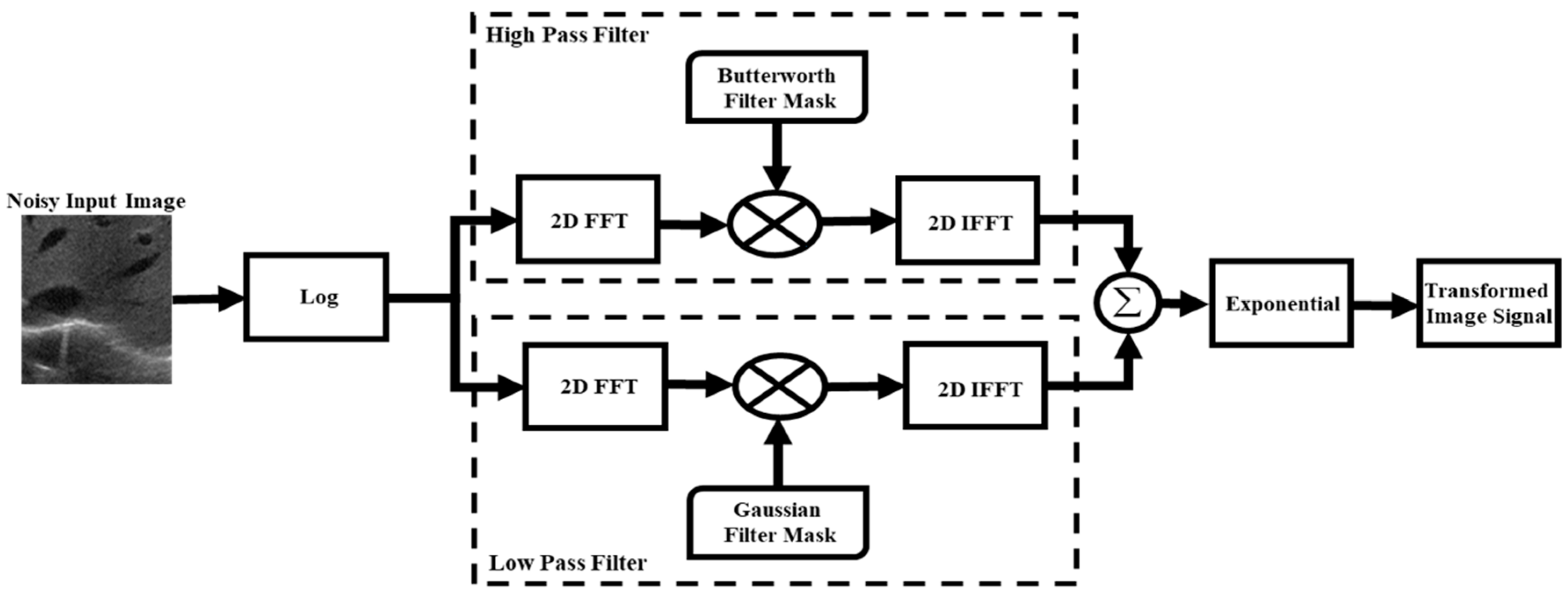

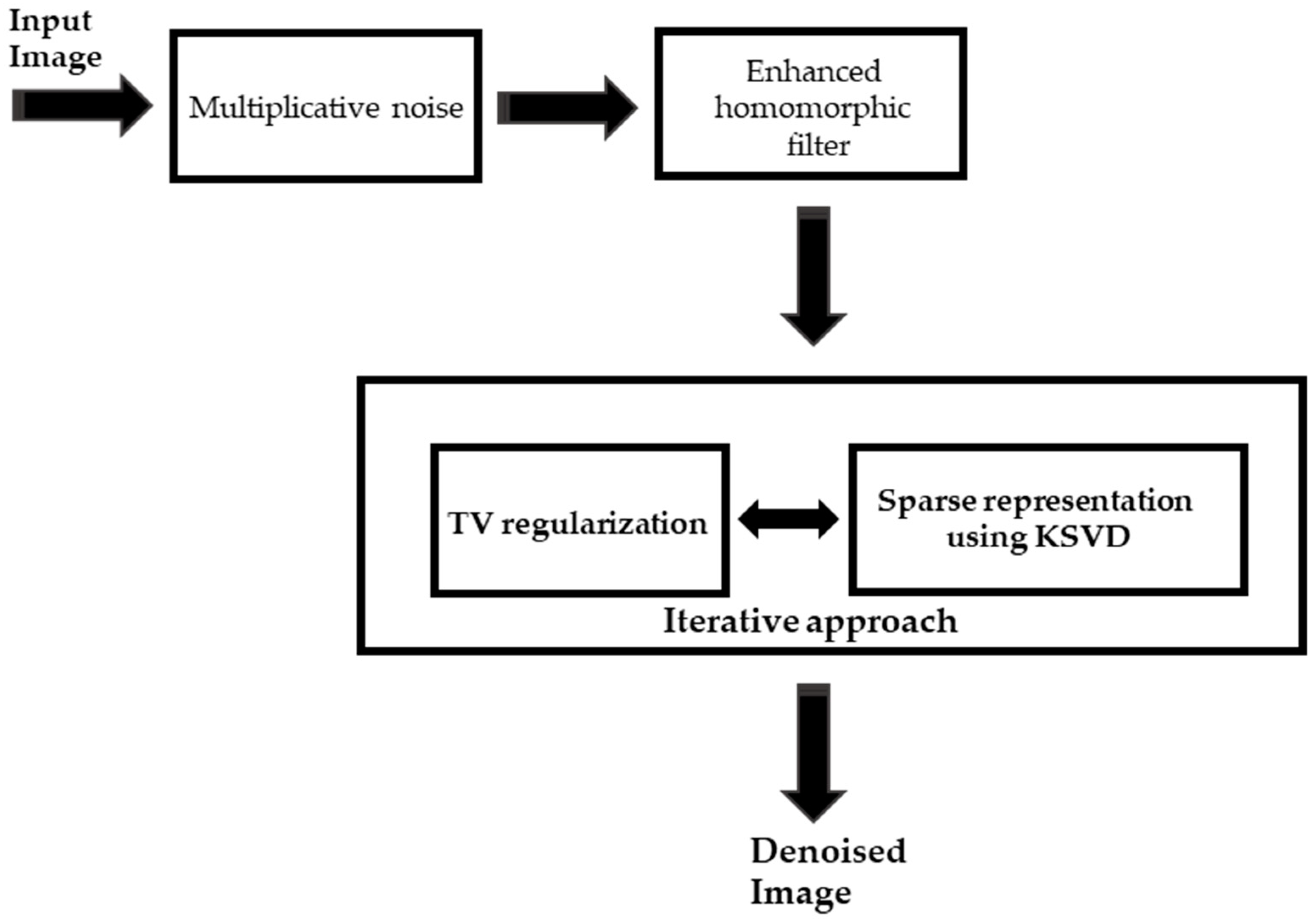
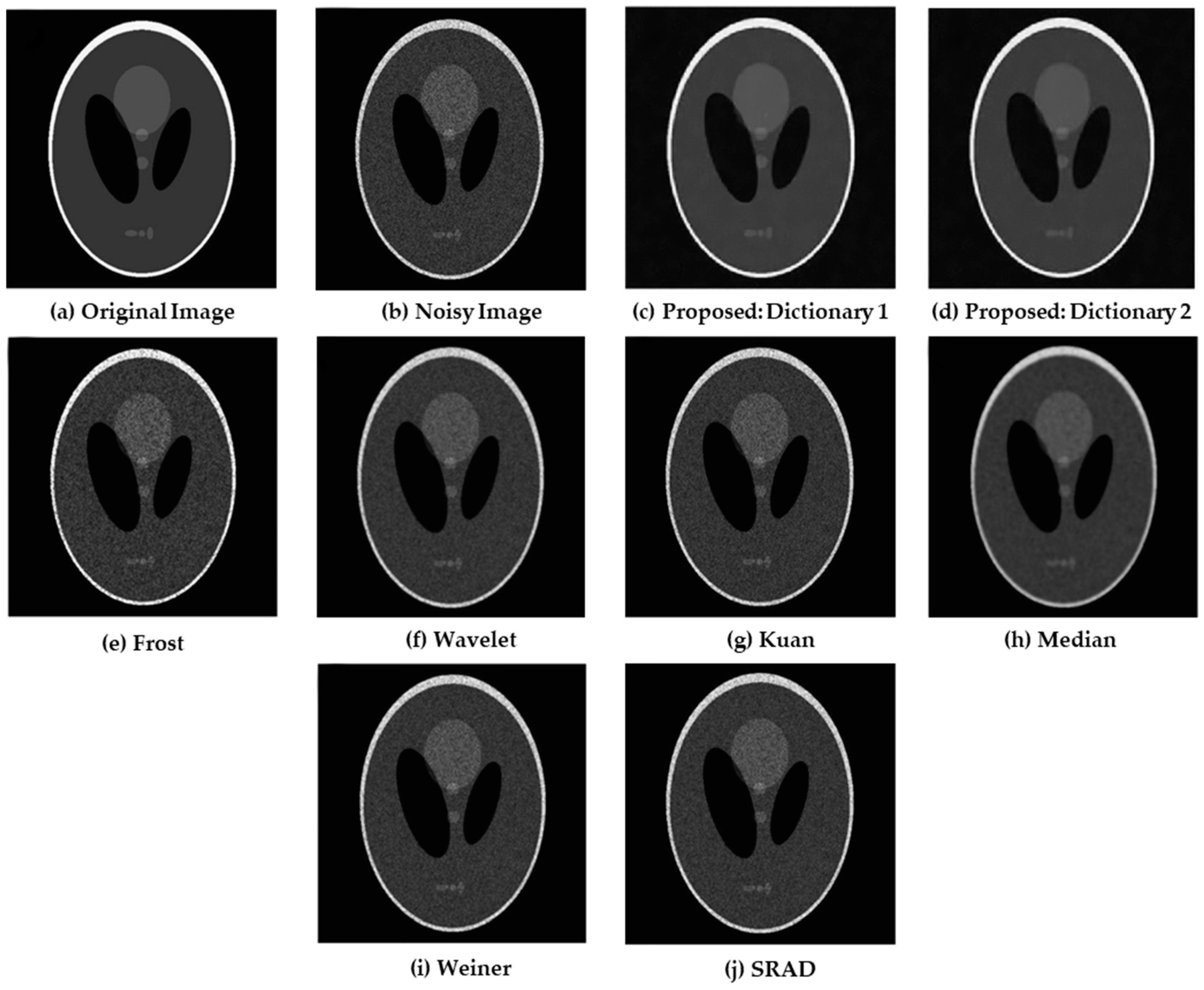


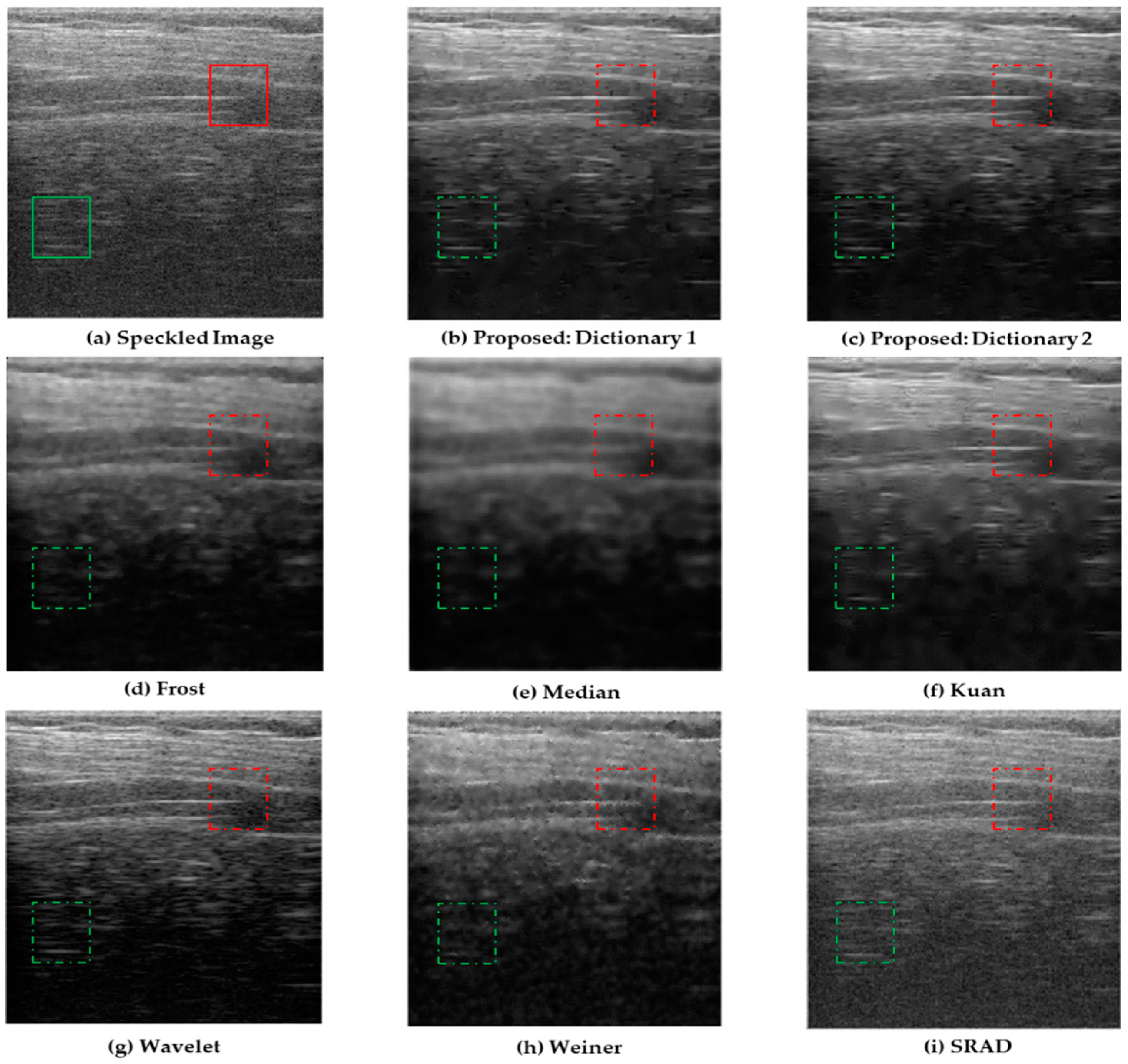


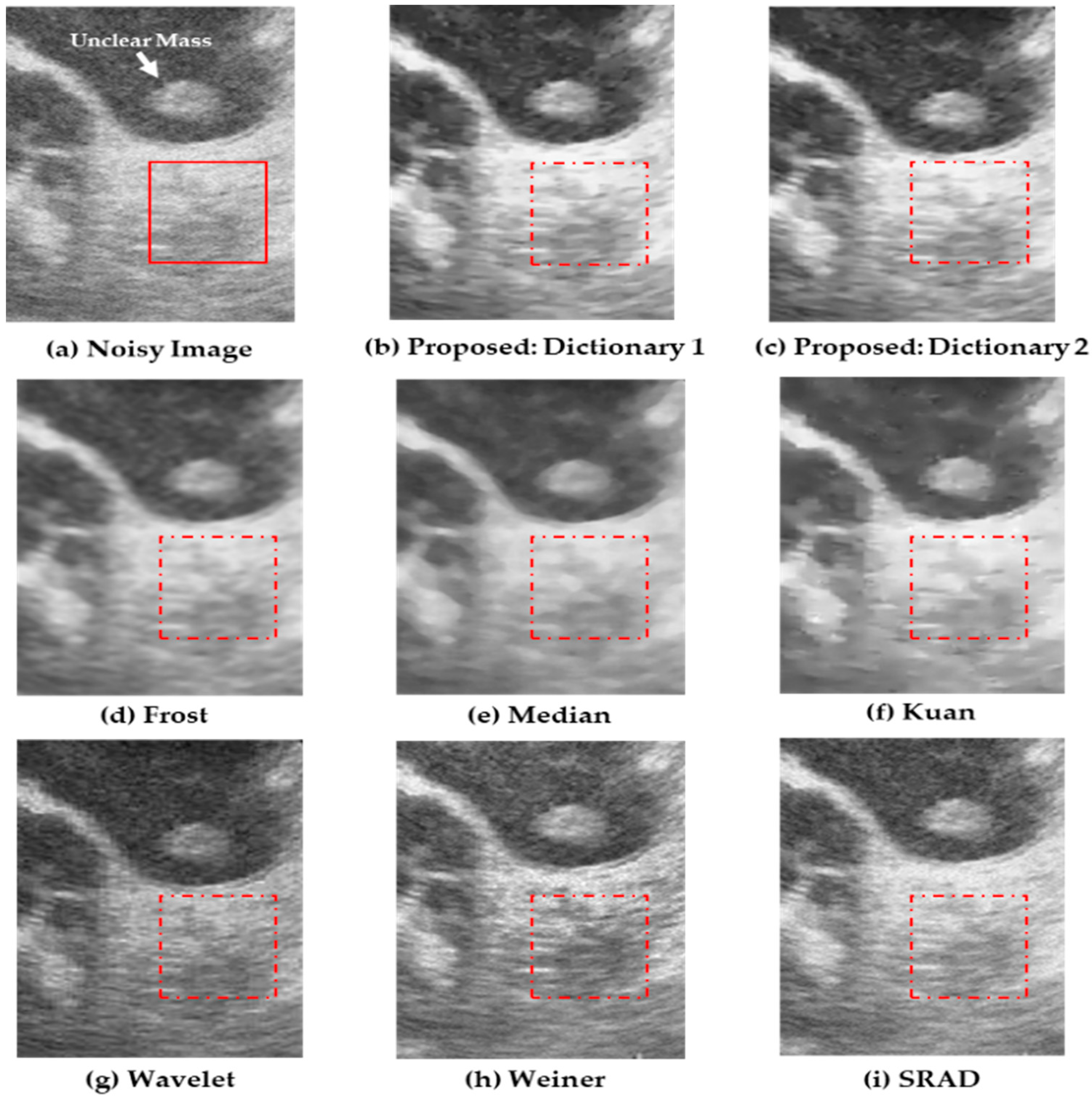
| Models | PSNR (dB) | MSSIM |
|---|---|---|
| Noise image | 32.113 | 0.727 |
| Frost | 32.466 | 0.768 |
| Wavelet | 33.214 | 0.801 |
| Kuan | 32.895 | 0.794 |
| Median | 34.597 | 0.839 |
| SRAD | 33.434 | 0.827 |
| Weiner | 33.782 | 0.834 |
| Proposed: Dictionary 1 | 36.862 | 0.953 |
| Proposed: Dictionary 2 | 37.044 | 0.967 |
| Models | PSNR (dB) | MSSIM |
|---|---|---|
| Frost | 28.966 | 0.822 |
| Median | 25.497 | 0.659 |
| Wavelet | 27.772 | 0.782 |
| SRAD | 28.766 | 0.813 |
| Kuan | 28.279 | 0.801 |
| Weiner | 29.218 | 0.834 |
| Proposed: Dictionary 1 | 30.334 | 0.901 |
| Proposed: Dictionary 2 | 30.807 | 0.926 |
© 2018 by the authors. Licensee MDPI, Basel, Switzerland. This article is an open access article distributed under the terms and conditions of the Creative Commons Attribution (CC BY) license (http://creativecommons.org/licenses/by/4.0/).
Share and Cite
Jabarulla, M.Y.; Lee, H.-N. Speckle Reduction on Ultrasound Liver Images Based on a Sparse Representation over a Learned Dictionary. Appl. Sci. 2018, 8, 903. https://doi.org/10.3390/app8060903
Jabarulla MY, Lee H-N. Speckle Reduction on Ultrasound Liver Images Based on a Sparse Representation over a Learned Dictionary. Applied Sciences. 2018; 8(6):903. https://doi.org/10.3390/app8060903
Chicago/Turabian StyleJabarulla, Mohamed Yaseen, and Heung-No Lee. 2018. "Speckle Reduction on Ultrasound Liver Images Based on a Sparse Representation over a Learned Dictionary" Applied Sciences 8, no. 6: 903. https://doi.org/10.3390/app8060903






